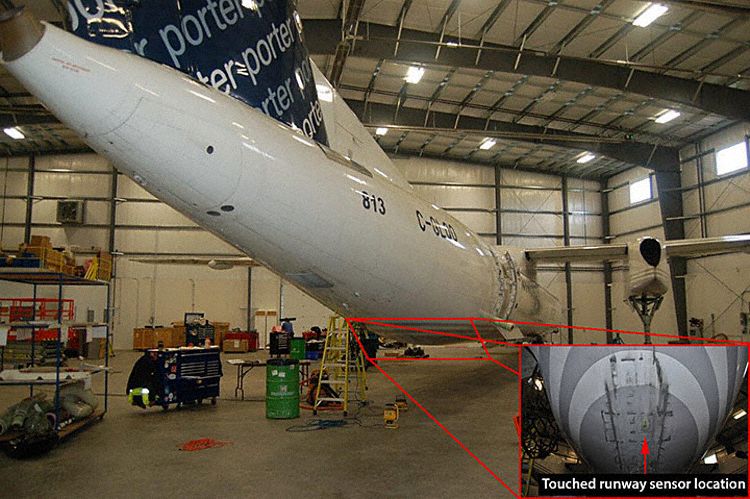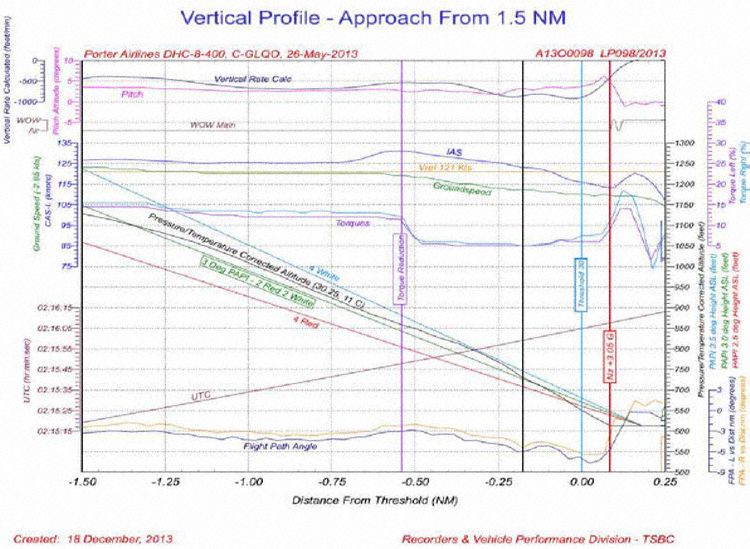Dash 8 Tail Strike: Weakness in Stabilised Approach Procedures
The Canadian Transportation Safety Board (TSB) has released their final report on a heavy landing and tail strike that occurred to Porter Airlines Bombardier Dash 8 Q400 C-GLQO landing at Sault Ste. Marie Airport on 26 May 2013. The aircraft landed hard and the tail of the aircraft contacted the runway resulting in significant damage but no injuries. Their report highlights a weakness in the operators stabilised approach procedures.
The Commander was Pilot Monitoring (PM). The First Officer was Pilot Flying (PF). The FO had 134 hours on type and during line training, training captains had identified:
…several areas requiring improvement amongst them pitch/power management during approaches and “the elimination of large power changes to chase speed in descent”.
The TSB describe how:
The aircraft descended through 500 feet AGL at 127 KIAS (Vref+6) on the extended center line of the runway, the captain made the “stabilized” call which was acknowledged by the first officer. Shortly afterwards the aircraft began to drift above the glidepath, the first officer applied pitch down inputs and the airspeed increased, however, the aircraft continued to drift above the glidepath nearing the 3.5 degrees angle. The first officer reduced engine power from 13% to 5% (flight idle) and pitched the nose down slightly, the airspeed began to decay rapidly and the rate of descent increased. The captain focused on the visual did not notice the power change, the accelerating rate of descent and decreasing airspeed. Descending through 90 feet AGL the airspeed dropped below Vref, descending through 40 feet AGL over the runway threshold the airspeed had decayed to 116 KIAS (Vref-5) and the aircraft had descended below the 2.5 degrees approach angle. The captain noticed that the aircraft was too low and the rate of descent had increased to 900 fpm and called for power. The first officer increased the pitch angle, then applied power just as the aircraft touched down at a recorded 7.3 degrees nose up (the TSB made the annotation that due to the sampling interval the actual attitude might have peaked at a higher angle) and +3.05G. 7.3 degrees nose up with gear fully or near fully compressed is consistent with a tail strike.
The TSB report that:
As the aircraft passed through approximately 90 feet HAT, the airspeed dropped below VREF and continued to decrease. At the same time, the vertical speed was increasing above -800 fpm and the aircraft was drifting below the ideal 3° PAPI glide path. The PM did not notice the increased rate of descent, most likely because he was monitoring the visual approach out the window at this point and not the aircraft instruments. As a result, no call-out for a go-around, as required by the company SOP, was made by the PM when the airspeed dropped below VREF. Continuing the approach when an aircraft does not meet the criteria for a stabilized approach is cited by the Flight Safety Foundation as being a contributing factor in 66% of approach and landing accidents and serious incidents. Neither crew member identified that the airspeed had dropped below VREF; the flight no longer met the requirements of a stabilized approach, and an overshoot was required.
The TSB concluded that the “stabilized” call at 500 feet was justified as all stabilized approach criteria laid out in the standard operating procedures of the operator were fulfilled. The TSB however also note (emphasis added here):
The company SOP defines the criteria for a stabilized approach; however, one item that is not mentioned is glide path when using visual glide scope indicators such as the PAPI. There are indications for instrument landing system (ILS) glide slope deviation, which would be applicable during an ILS approach, but no limits for the visual approach. The FDR data clearly indicate that the aircraft was constantly deviating above and below the glide path after the autopilot was disconnected, yet by company SOP the aircraft met all the criteria for a stabilized approach while passing through 500 feet HAT. The only defined parameter that made the approach unstable was when the indicated airspeed dropped below VREF at 90 feet HAT.
More can be found on the FSF Approach and Landing Accident Reduction (ALAR) project here.
Last year Aerossurance highlighted lessons from Dash 8 unstable approach in crosswind in Greenland.
UPDATE 10 March 2017: Unstable Approach Dash 8 Touches Down 450ft Before Threshold
UPDATE 24 April 2017: Unstabilised CL-600 Approach Accident at Aspen



Recent Comments